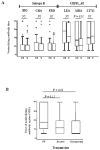Maternal neutralizing antibodies against a CRF01_AE primary isolate are associated with a low rate of intrapartum HIV-1 transmission
- PMID: 19303619
- PMCID: PMC4468066
- DOI: 10.1016/j.virol.2009.02.024
Maternal neutralizing antibodies against a CRF01_AE primary isolate are associated with a low rate of intrapartum HIV-1 transmission
Abstract
Mother-to-child transmission (MTCT) of HIV-1 provides a model for studying the role of passively acquired antibodies in preventing HIV infection. We determined the titers of neutralizing antibodies (NAbs) against six primary isolates of clades B and CRF01_AE in sera from 45 transmitting and 45 nontransmitting mothers matched for the main independent factors associated with MTCT in Thailand. A lower risk of MTCT, particularly for intrapartum transmission, was associated only with higher NAb titers against the CRF01_AE strain, MBA. The envelope glycoprotein of this strain showed an unusually long V2 domain of 63 amino acids, encoding six potential N-linked glycosylation sites. We provided experimental data indicating that the extended V2 domain contributed to the higher level of resistance to neutralization by mothers' sera in this strain. Taken together the data suggest that some primary isolates with specific properties may be useful indicators for identifying protective antibodies.
Figures




Similar articles
-
Maternal Neutralization-Resistant Virus Variants Do Not Predict Infant HIV Infection Risk.mBio. 2016 Feb 2;7(1):e02221-15. doi: 10.1128/mBio.02221-15. mBio. 2016. PMID: 26838723 Free PMC article.
-
Maternal but Not Infant Anti-HIV-1 Neutralizing Antibody Response Associates with Enhanced Transmission and Infant Morbidity.mBio. 2017 Oct 24;8(5):e01373-17. doi: 10.1128/mBio.01373-17. mBio. 2017. PMID: 29066544 Free PMC article.
-
Mother to child transmission of HIV-1 in a Thai population: role of virus characteristics and maternal humoral immune response.J Med Virol. 2009 May;81(5):768-78. doi: 10.1002/jmv.21465. J Med Virol. 2009. PMID: 19319941 Clinical Trial.
-
Protection of neonatal macaques against experimental SHIV infection by human neutralizing monoclonal antibodies.Transfus Clin Biol. 2001 Aug;8(4):350-8. doi: 10.1016/s1246-7820(01)00187-2. Transfus Clin Biol. 2001. PMID: 11642027 Review.
-
[Role of the HIV-1 gp120 V1/V2 domains in the induction of neutralizing antibodies].Enferm Infecc Microbiol Clin. 2009 Nov;27(9):523-30. doi: 10.1016/j.eimc.2008.02.010. Epub 2009 May 1. Enferm Infecc Microbiol Clin. 2009. PMID: 19409660 Review. Spanish.
Cited by
-
HIV-specific antibodies capable of ADCC are common in breastmilk and are associated with reduced risk of transmission in women with high viral loads.PLoS Pathog. 2012;8(6):e1002739. doi: 10.1371/journal.ppat.1002739. Epub 2012 Jun 14. PLoS Pathog. 2012. PMID: 22719248 Free PMC article.
-
Mutations that confer resistance to broadly-neutralizing antibodies define HIV-1 variants of transmitting mothers from that of non-transmitting mothers.PLoS Pathog. 2021 Apr 2;17(4):e1009478. doi: 10.1371/journal.ppat.1009478. eCollection 2021 Apr. PLoS Pathog. 2021. PMID: 33798244 Free PMC article.
-
HIV-1 autologous antibody neutralization associates with mother to child transmission.PLoS One. 2013 Jul 17;8(7):e69274. doi: 10.1371/journal.pone.0069274. Print 2013. PLoS One. 2013. PMID: 23874931 Free PMC article.
-
Evidence for efficient vertical transfer of maternal HIV-1 envelope-specific neutralizing antibodies but no association of such antibodies with reduced infant infection.J Acquir Immune Defic Syndr. 2013 Oct 1;64(2):163-6. doi: 10.1097/QAI.0b013e31829f6e41. J Acquir Immune Defic Syndr. 2013. PMID: 23774880 Free PMC article. Clinical Trial.
-
Rapid high-level production of functional HIV broadly neutralizing monoclonal antibodies in transient plant expression systems.PLoS One. 2013;8(3):e58724. doi: 10.1371/journal.pone.0058724. Epub 2013 Mar 22. PLoS One. 2013. PMID: 23533588 Free PMC article.
References
-
- Barin F, Brunet S, Brand D, Moog C, Peyre R, Damond F, Charneau P, Barre-Sinoussi F. Interclade neutralization and enhancement of human immunodeficiency virus type 1 identified by an assay using HeLa cells expressing both CD4 receptor and CXCR4/CCR5 coreceptors. J Infect Dis. 2004;189(2):322–7. - PubMed
-
- Barin F, Jourdain G, Brunet S, Ngo-Giang-Huong N, Weerawatgoompa S, Karnchanamayul W, Ariyadej S, Hansudewechakul R, Achalapong J, Yuthavisuthi P, Ngampiyaskul C, Bhakeecheep S, Hemwutthiphan C, Lallemant M. Revisiting the role of neutralizing antibodies in mother-to-child transmission of HIV-1. J Infect Dis. 2006;193(11):1504–11. - PubMed
-
- Bongertz V, Costa CI, Veloso VG, Grinsztejn B, Joao Filho EC, Calvet G, Pilotto JH, Guimaraes ML, Morgado MG. Vertical HIV-1 transmission: importance of neutralizing antibody titer and specificity. Scand J Immunol. 2001;53(3):302–9. - PubMed
-
- Braibant M, Brunet S, Costagliola D, Rouzioux C, Agut H, Katinger H, Autran B, Barin F. Antibodies to conserved epitopes of the HIV-1 envelope in sera from long-term non-progressors : prevalence and association with neutralizing activity. AIDS. 2006;20 (15):1923–1930. - PubMed
Publication types
MeSH terms
Substances
Grants and funding
LinkOut - more resources
Full Text Sources
Medical
Molecular Biology Databases

